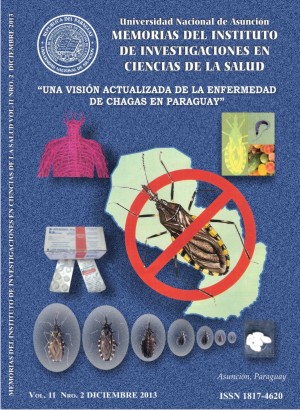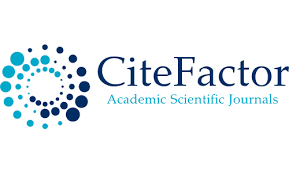Cepas de Trypanosoma cruzi en el Paraguay
Palabras clave:
cepas de Trypanosoma cruzi, Enfermedad de Chagas, ParaguayResumen
Las poblaciones del Trypanosoma cruzi que circulan en Paraguay han mostrado una gran diversidad genética, la cual ha sido evaluada usando diferentes metodologías y técnicas. Se han identificado varios genotipos de este parásito infectando una diversidad de hospederos, incluyendo pacientes, vinchucas, animales silvestres y domésticos de diferentes regiones. La diversidad genética observada en los aislados de nuestro país podría implicar diferencias en las manifestaciones clínicas de la enfermedad de Chagas, así como diferencias en sus características biológicas, como ser el grado de infectividad, virulencia, patogenicidad, capacidad antigénica y susceptibilidad o resistencia a las drogas tripanocidas. Hasta el momento, estos aspectos han sido poco explorados y evaluados en las cepas paraguayas. El aislamiento e identificación del grupo y subgrupos de T. cruzi, que circulan en los diferentes ciclos de transmisión en una determinada región geográfica, siguen siendo relevantes porque permiten conocer la dinámica de transmisión del parásito y evaluar el riesgo de introducción a partir de focos selváticos.
Descargas
Citas
Dias JCP.- Epidemiologia. En: Brener Z, Andrade ZA, ed. Trypanosoma cruzi e doença de Chagas. Rio de Janeiro: Guanabara Koogan; 2000. p. 48-54.
Barretto MP. - Epidemiologia. En: Brener Z, Andrade ZA, ed. Trypanosoma cruzi e doença de Chagas. Rio de Janeiro: Guanabara Koogan; 1979. p. 89-151.
Zingales B, Andrade SG, Briones MR, Campbell DA, Chiari E, Fernandes O et al. Second Satellite Meeting. A new consensus for Trypanosoma cruzi intraspecific nomenclature: second revision meeting recommends TcI to TcVI. Mem Inst Oswaldo Cruz. 2009 Nov; 104(7):1051-4.
Zingales B, Miles MA, Campbell DA, Tibayrenc M, Macedo AM, Teixeira MM et al. The revised Trypanosoma cruzi subspecific nomenclature: rationale, epidemiological relevance and research applications. Infect Genet Evol. 2012 Mar; 12(2):240-53.
Tibayrenc, M. Genetic epidemiology of parasitic protozoa and other infectious agents: the need for an integrated approach. Int J Parasitol. 1998; 28(1):85-104.
Yeo M, Acosta N, Llewellyn M, Sanchez H, Adamson S, Miles GA et al. Origins of Chagas disease: Didelphis species are natural hosts of Trypanosoma cruzi I and armadillos hosts of Trypanosoma cruzi II, including hybrids. Int J Parasitol. 2005; 35(2):225-33.
Miles MA, Llewellyn MS, Lewis MD, Yeo M, Baleela R, Fitzpatrick S et al. The molecular epidemiology and phylogeography of Trypanosoma cruzi and parallel research on Leishmania: looking back and to the future. Parasitology. 2009 Oct; 136(12):1509-28.
Herrera C, Bargues MD, Fajardo A, Montilla M, Triana O, Vallejo GA et al. Identifying four Trypanosoma cruzi I isolate haplotypes from different geographic regions in Colombia. Infect Genet Evol. 2007 Jul; 7(4):535-9.
Cura CI, Mejía-Jaramillo AM, Duffy T, Burgos JM, Rodriguero M, Cardinal MV et al. Trypanosoma cruzi I genotypes in different geographical regions and transmission cycles based on a microsatellite motif of the intergenic spacer of spliced-leader genes. Int J Parasitol. 2010 Dec; 40(14):1599-607.
Camargo E. Growth and differentiation in Trypanosoma cruzi I. Origen of metacyclic trypanosomes in liquid media. Rev Inst Med Trop São Paulo. 1964;6:93-100.
Walton BC, Shaw JJ, Lainson R. Observations on the "in vitro" cultivation of Leishmania braziliensis. J Parasitol 1977; 63:1118-9.
Morel C, Chiari E, Camargo EP, Mattei DM, Romanha AJ, Simpson L. Strains and clones of Trypanosoma cruzi can be characterized by pattern of restriction endonuclease products of kinetoplast DNA minicircles. Proc Natl Acad Sci USA. 1980; 77:6810-4.
Miles MA, Souza A, Povoa M, Shaw JJ, Lainson R, Toye PJ. Isozymic heterogeneity of Trypanosoma cruzi in the first autochthonous patients with Chagas’ disease in Amazonian Brazil. Nature. 1978; 272:819-821.
Tibayrenc M, Ayala FJ. Isoenzyme variability of Trypanosoma cruzi the agent of Chagas’ disease: genetical, taxonomical and epidemiological significance. Evolution. 1988; 42:277-292.
Souto RP, Fernandes O, Macedo AM, Campbell DA, Zingales B. DNA markers define two major phylogenetic lineages of Trypanosoma cruzi. Mol Biochem Parasitol. 1996; 83:141-52.
Mem. Inst. Investig. Cienc. Salud, Vol. 9(2) Diciembre 2013: 88-89 88
Fernandes O, Souto R, Castro J, Pereira J, Fernandes N, Junqueira A et al. Brazilian isolates of Trypanosoma cruzi from humans and triatomines classified into two lineages using mini-exon and ribosomal RNA sequences. Am J Trop Med Hyg. 1998; 58:807-811.
Brisse S, Verhoef J, Tibayrenc M. Characterisation of large and small subunit rRNA and mini-exon genes further supports the distinction of six Trypanosoma cruzi lineages. Int J Parasitol. 2001; 31:1218-26.
Martinez-Diaz RA, Escario JA, Nogal-Ruiz JJ, Gomez-Barrio A. Relationship between biological behaviour and randomly amplified polymorphic DNA profiles of Trypanosoma cruzi strains. Mem Inst Oswaldo Cruz. 2001; 96(2):251-6.
Rozas M, Doncker SD, Adaui V, Coronado X, Barnabe C, Tibyarenc M et al. Multilocus Polymerase Chain Reaction Restriction Fragment-Length Polymorphism Genotyping of Trypanosoma cruzi (Chagas Disease): Taxonomic and Clinical Applications. J Infec Dis. 2007; 195:1381-1388.
Lewis MD, Ma J, Yeo M, Carrasco HJ, Llewellyn MS, Miles MA. Genotyping of Trypanosoma cruzi: systematic selection of assays allowing rapid and accurate discrimination of all known lineages. Am J Trop Med Hyg. 2009; 81:1041-1049.
Veas F, Brenière SF, Cuny G, Brengues C, Solari A, Tibayrenc M. General procedure to construct highly specific kDNA probes for clones of Trypanosoma cruzi for sensitive detection by polymerase chain reaction. Cell Mol Biol. 1991; 37:73–84.
Duffy T, Bisio M, Altcheh J, Burgos JM, Diez M, Levin MJ et al. Accurate real-time PCR strategy for monitoring bloodstream parasitic loads in Chagas disease patients. PLoS Negl Trop Dis. 2009; 3(4): e419.
Bhattacharyya T, Brooks J, Yeo M, Carrasco HJ, Lewis MD, Llewellyn MS et al. Analysis of molecular diversity of the Trypanosoma cruzi trypomastigote small surface antigen reveals novel epitopes, evidence of positive selection and potential implications for lineage-specific serology. Int J Parasitol. 2010 Jul; 40(8):921-8.
Risso MG, Sartor PA, Burgos JM, Briceño L, Rodríguez EM, Guhl F et al. Immunological identification of Trypanosoma cruzi lineages in human infection along the endemic area. Am J Trop Med Hyg. 2011 Jan; 84(1):78-84.
Yeo M, Mauricio IL, Messenger LA, Lewis MD, Llewellyn MS, Acosta N et al. Multilocus sequence typing (MLST) for lineage assignment and high resolution diversity studies in Trypanosoma cruzi. PLoS Negl Trop Dis. 2011; 5(6):e1049.
D’Avila DA, Macedo AM, Valadares HM, Gontijo ED, de Castro AM, Machado CR et al. Probing population dynamics of Trypanosoma cruzi during progression of the chronic phase in chagasic patients. J Clin Microbiol. 2009; 47:1718–25.
Burgos JM, Diez M, Vigliano C, Bisio M, Risso M, Duffy T, et al. Molecular identification of Trypanosoma cruzi discrete typing units in end-stage chronic Chagas heart disease and reactivation after heart transplantation. Clin Infect Dis. 2010 Set; 51(5):485-95.
Chapman MD, Baggaley RC, Godfrey-Fausset PF, Malpas TJ, White G, Canese J, Miles MA. Trypanosoma cruzi from the Paraguayan Chaco: isoenzyme profiles of strains isolated at Makthlawaiya. J Protozool. 1984; 31:482-6.
Yamasaki H, Kita K, Oya H, Pavon B, Arias O, Moran M, Vera M. Shizodeme characterization of kinetoplast DNA minicircles of Trypanosoma cruzi and Leishmania isolates from Paraguayan Chagas; disease and leishmaniasis patients. Japan J Trop Med Hyg. 1990; 18:62-63.
Mimori T, Maldonado M, Samudio M, Rojas de Arias A, Moreno R, Sakamoto M. Characterization of Trypanosoma cruzi isolates from Paraguay, using restriction enzyme analysis of kinetoplast DNA. Ann Trop Med Parasitol. 1992;86:231-237.
Baba S, Matsumoto T, Kanbara H, Sakamoto M, Maldonado M, Rojas de Arias A et al. Comparative study of random amplified polymorphic DNA of Trypanosoma cruzi isolates from Paraguay. Japan J Trop Med Hyg. 1999; 18:62-63.
Acosta N, Samudio M, López E, Vargas F, Yaksic N, Brenière SF, Rojas de Arias A. Isoenzyme profiles of Trypanosoma cruzi stocks from different areas of Paraguay. Mem Inst Oswaldo Cruz. 2001 May; 96(4):527-33.
Higo H, Miura S, Horio M, Mimori T, Hamano S, Agatsuma T et al. Genotypic variation among lineages of Trypanosoma cruzi and its geographic aspects. Parasitol Int. 2004 Dec; 53(4):337-44.
del Puerto F, Sánchez Z, Nara E, Meza G, Paredes B, Ferreira E et al. Trypanosoma cruzi lineages detected in congenitally infected infants and Triatoma infestans from the same disease-endemic region under entomologic surveillance in Paraguay. Am J Trop Med Hyg. 2010 Mar; 82(3):386-90.
Sánchez Z. Rol del Triatoma sórdida en la transmisión de la Enfermedad de Chagas en el Paraguay. (Tesis de Maestría). Instituto de Investigaciones en Ciencias de la Salud, Universidad Nacional de Asunción. 2011.
Machado CA, Ayala FJ. Nucleotide sequences provide evidence of genetic exchange among distantly related lineages of Trypanosoma cruzi. Proc Natl Acad Sci USA. 2001; 98:7396-401.
Lewis MD, Llewellyn MS, Yeo M, Acosta N, Gaunt MW, Miles MA. Recent, independent and anthropogenic origins of Trypanosoma cruzi hybrids. PLoS Negl Trop Dis. 2011 Oct; 5(10):e1363.
Llewellyn MS, Lewis MD, Acosta N, Yeo M, Carrasco HJ, Segovia M et al. Trypanosoma cruzi IIc: phylogenetic and phylogeographic insights from sequence and microsatellite analysis and potential impact on emergent Chagas disease. PLoS Negl Trop Dis. 2009 Sep; 3(9):e510.
Yeo M, Lewis MD, Carrasco HJ, Acosta N, Llewellyn M, da Silva Valente SA et al. Resolution of multiclonal infections of Trypanosoma cruzi from naturally infected triatomine bugs and from experimentally infected mice by direct plating on a sensitive solid medium. Int J Parasitol. 2007 Jan; 37(1):111-20.
Acosta N, Maldonado M, Sanabria L, Yaluff G, Fuentes S, Torres S et al. Characterization of Paraguayan Trypanosoma cruzi strains isolated from acute patients of Chagas disease. Trop Med Parasitol. 1995 Sep; 46(3):195-200.
Magalhães JB, Pontes AL, Andrade SG. Behavior of the Y and Peruvian strains of Trypanosoma cruzi in mice, after passage through various media. Mem Inst Oswaldo Cruz. 1985 Jan-Mar; 80(1):41-50.
Andrade SG, Magalhães JB. Biodemes and zymodemes of Trypanosoma cruzi strains: correlations with clinical data and experimental pathology. Rev Soc Bras Med Trop. 1996 Jan-Feb; 30(1):27-35.
Rojas De Arias A. Chagas disease in Paraguay. PAHO/HCP/HCT/72/96, 1996.
Andrade SG, Magalhães JB, Pontes AL. Evaluation of chemotherapy with benznidazole and nifurtimox in mice infected with Trypanosoma cruzi strains of different types. Bull World Health Org. 1985; 63(4):721-6.
Gomes ML, Toledo MJ, Nakamura CV, Bittencourt Nde L, Chiari E, de Araújo SM. Trypanosoma cruzi: genetic group with peculiar biochemical and biological behavior. Mem Inst Oswaldo Cruz. 2003 Jul; 98(5):649-54.
Mejia-Jaramillo AM, Fernández GJ, Montilla M, Nicholls RS, Triana-Chávez O. Estudio de la susceptibilidad al benznidazol de cepas de Trypanosoma cruzi sugiere la circulación de cepas naturalmente resistentes en Colombia. Biomédica. 2012; 32(2):196-205.














